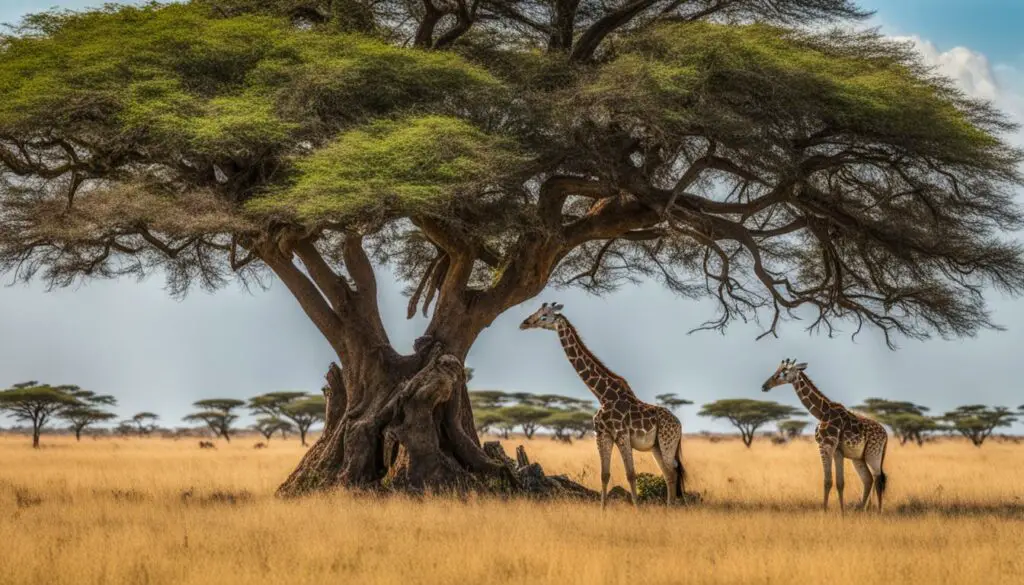Have you ever wondered about giraffes’ sleep patterns, sleeping habits, and sleep behavior? Giraffes have unique sleep habits compared to other animals, and it’s fascinating to learn more about how they rest and recharge.
When it comes to sleep, giraffes only sleep for a few hours a day, both standing up and lying down. Their sleep patterns are influenced by their need for self-defense and their feeding behavior. Let’s delve into the details to understand more about these majestic creatures’ sleep habits.
Giraffes’ REM Sleep and Sleep Duration
When it comes to sleep, giraffes have some fascinating habits. While they spend most of their time awake, they do require sleep to function properly. One interesting aspect of giraffes’ sleep behavior is their REM sleep, which is similar to the rapid eye movement sleep that humans experience. During REM sleep, giraffes may exhibit twitching or movement of their eyes, suggesting that they are dreaming. This type of sleep is important for cognitive processes and memory consolidation.
However, giraffes’ overall sleep duration is relatively short compared to other animals. On average, adult giraffes sleep for about 30 minutes a night, and their sleep cycles are typically around 35 minutes or shorter. This brief period of sleep is divided into short bursts that rarely exceed five minutes. Despite their limited sleep time, giraffes seem to function well and thrive in their natural habitat.
“Giraffes may have shorter sleep durations compared to other animals, but their sleep patterns are perfectly suited to their unique needs and environment.”
Giraffes have evolved to sleep standing up, which is a behavior known as standing sleep. They can sleep while standing, with their head slightly inclined forward, allowing them to remain alert and ready to defend against potential predators. This adaptation is vital for their survival, as lying down for extended periods would leave them vulnerable to attacks. The short bursts of sleep and constant vigilance help giraffes stay safe and protected in the wild.
| Type of Sleep | Description |
|---|---|
| Standing Sleep | Giraffes sleep while standing up with their head slightly inclined forward. |
| Recumbent Sleep | Giraffes lie down with their legs folded under them, their necks arched backward, and their heads resting on their rumps or the ground. |
| Paradoxical Sleep | Giraffes experience a sleep state similar to REM sleep in humans, characterized by rapid eye movement. |
Overall, giraffes have unique sleep patterns that are perfectly suited to their needs. Their short sleep duration and ability to sleep standing up are adaptations that help them survive in the wild. So, while giraffes may not sleep as much as other animals, they have found effective ways to balance rest and vigilance in their fascinating sleep behavior.
The reasons behind giraffes’ sleep patterns
Giraffes have unique sleep patterns that are influenced by several factors. One of the main reasons for their sleep behavior is the need for self-defense. Unlike many other animals, giraffes are vulnerable when lying down for extended periods. As large animals without built-in protective features, such as thick hides or sharp teeth, they rely on minimal sleep to stay alert and defend themselves against potential predators.
In their natural habitat, giraffes face the constant threat of nearby predators, and lying down makes them an easy target. Therefore, they have adapted to sleep in short bursts, often standing up with their heads and necks curved around to rest on their hindquarters. This position allows them to quickly respond to any potential danger.
Another reason for giraffes’ limited sleep is their feeding behavior. As ruminants, giraffes spend a significant portion of their day chewing on cud to obtain sufficient calories. This leaves them with less time for sleep. To survive and meet their nutritional needs, giraffes prioritize feeding over sleep, dedicating more time to grazing and digesting food.
Overall, giraffes’ sleep patterns are a result of their need for self-defense and their feeding behavior. By minimizing their sleep duration and remaining in a constant state of vigilance, giraffes have evolved strategies to survive and thrive in their natural habitat.
| Animal | Sleep Duration (Average) |
|---|---|
| Giraffes | 30 minutes per day |
| Elephants | 3-4 hours per day |
| Horses | 2-3 hours per day |
Giraffes’ sleep habits compared to other animals
Giraffes’ sleep patterns are unique among land mammals and differ significantly from other animals. While most animals have longer sleep durations, giraffes sleep for much shorter periods, both in captivity and in the wild. In captivity, adult giraffes sleep for about four and a half hours a day, while in the wild, they sleep for approximately 40 minutes a day.
To better understand the contrast in sleep patterns, let’s compare giraffes with two other animals: elephants and horses. Elephants, known for their size, require an average of 3-6 hours of sleep per day, while horses require around 2-3 hours. Giraffes, on the other hand, sleep significantly less.
These unique sleep habits are a result of the challenges giraffes face in their habitat and their need to graze for extended periods to obtain sufficient calories. Unlike elephants and horses that can graze while lying down, giraffes have to remain standing to feed. This grazing behavior, combined with their vulnerability when lying down for extended periods, limits their sleep duration.
| Giraffes | Elephants | Horses | |
|---|---|---|---|
| Sleep Duration (In Captivity) | 4.5 hours | 3-6 hours | 2-3 hours |
| Sleep Duration (In the Wild) | 40 minutes | N/A | N/A |
As the table above illustrates, giraffes have one of the shortest sleep durations among land mammals, emphasizing their distinctive sleep patterns within the animal kingdom.

Giraffes’ sleep compared to other animals
Sleep Habits of Baby Giraffes
When it comes to sleep, baby giraffes, also known as calves, have their own unique behavior. Unlike adult giraffes, calves sleep lying down about a quarter of the time, with their heads resting on their rumps. This position provides them with a sense of security and comfort while they rest. Baby giraffes require more sleep than their adult counterparts as they undergo rapid growth and development during this stage of their lives.
Due to their vulnerability, baby giraffes rely heavily on their mothers and the protective presence of the group, known as a tower, to ensure their safety while sleeping. The mothers are always on high alert, keeping a watchful eye over their calves, and will often position themselves in a way that creates a physical barrier between the calf and potential threats.
It’s fascinating to observe the sleep habits of baby giraffes and how they differ from adults. While adult giraffes adopt a more vigilant approach to sleep, calves can enjoy a more relaxed and vulnerable position thanks to the protective measures taken by their mothers and the tower. This highlights the importance of safety and the strong bonds within the giraffe community.
| Sleep Pattern | Adult Giraffes | Baby Giraffes |
|---|---|---|
| Position | Standing up or lying down | Lying down with head on rump |
| Sleep Duration | Average of 30 minutes | More sleep compared to adults |
| Protection | Reliant on vigilance and alertness | Mother’s presence and tower’s protection |
Overall, the sleep habits of baby giraffes provide an insight into the nurturing and protective nature of the giraffe community. Their sleep behavior ensures their safety while allowing them to rest and grow during this crucial stage of their lives.
Theoretical reasons for giraffes’ limited sleep
Researchers have put forward several theories to explain the relatively short sleep duration of giraffes. One theory suggests that their limited sleep is primarily driven by the need for self-defense. As vulnerable prey animals, giraffes face a constant threat from predators in their natural habitat. Lying down for extended periods of time leaves them exposed and at risk of attack. By minimizing their sleep and staying vigilant, giraffes can quickly respond to potential threats and increase their chances of survival.
Another theory proposes that the feeding behavior of giraffes is a contributing factor to their short sleep duration. As ruminants, giraffes spend a significant amount of time grazing and consuming large volumes of foliage. The process of digesting their food requires energy and time, leaving them with limited opportunities for sleep. To meet their nutritional needs, giraffes prioritize feeding over sleep, dedicating a large portion of their day to obtaining sufficient calories from their diet.
Both of these theories highlight how the ecological and physiological demands placed on giraffes influence their sleep patterns. The need for self-defense and the requirements of their unique feeding behavior shape the sleep habits of these majestic creatures. By adapting to their environment and balancing the need for rest with the need for survival, giraffes have developed a sleep pattern that allows them to thrive in their natural habitat.
Giraffe Sleep Theories
- Self-defense: Giraffes minimize sleep to stay alert and defend against predators.
- Feeding behavior: Ruminant digestion requires time and energy, leaving less time for sleep.
This combination of factors results in giraffes having one of the shortest sleep durations among land mammals. The limited sleep of giraffes is a remarkable adaptation that allows them to survive and thrive in their unique habitat. As we continue to study these fascinating creatures, further research may uncover additional insights into their sleep patterns and the remarkable strategies they employ for survival.
Giraffes’ Sleep Behavior and Types
Giraffes have fascinating sleep behaviors that set them apart from other animals. They exhibit three main sleep types: standing sleep, recumbent sleep, and paradoxical sleep. Standing sleep is the most common, where giraffes sleep while standing up with their heads tilted slightly forward. This allows them to be alert and ready to defend themselves against potential predators. Recumbent sleep, on the other hand, involves giraffes lying down with their legs folded under them, their necks arched backward, and their heads resting on their rumps or the ground.
“Giraffes have unique sleep behaviors that allow them to adapt to their environment and protect themselves from predators.”
Paradoxical sleep, similar to REM sleep in humans, is observed less frequently in giraffes. During this stage, giraffes experience rapid eye movements and may dream. It is believed to play a vital role in their overall sleep cycle and is essential for their well-being. These various sleep behaviors demonstrate the adaptability of giraffes to their environment and their ability to balance rest and vigilance.
The sleep patterns of giraffes are not only intriguing but also reflect their unique needs as ruminant animals. While other animals may sleep longer, giraffes have adapted to survive with minimal sleep due to the challenges they face in the wild. They constantly balance the need for rest with the necessity to graze for extended periods to obtain sufficient calories. This delicate balance showcases the evolution and remarkable resilience of giraffes.
https://www.youtube.com/watch?v=yMv_WGXrtiM
Sleep Types of Giraffes
Giraffes exhibit three main sleep types: standing sleep, recumbent sleep, and paradoxical sleep. Each of these sleep behaviors serves a specific purpose in their daily lives. By understanding the sleep habits of giraffes, we can gain valuable insights into their unique biology and their strategies for survival.
| Sleep Type | Description |
|---|---|
| Standing Sleep | Giraffes sleep while standing up with their heads slightly inclined forward. This allows them to remain vigilant and ready to defend themselves. |
| Recumbent Sleep | Giraffes lie down with their legs folded under them, their necks arched backward, and their heads resting on their rumps or the ground. This type of sleep provides them with a more restful state. |
| Paradoxical Sleep | Similar to REM sleep in humans, paradoxical sleep is characterized by rapid eye movement. Giraffes experience this stage less frequently and it is believed to be crucial for their overall sleep cycle. |
Giraffes’ sleep behaviors and types not only showcase their incredible adaptability but also provide us with a deeper understanding of their unique biology and behaviors in the animal kingdom.
Conclusion
In conclusion, giraffes have unique sleep patterns that set them apart from other animals in the animal kingdom. They sleep both standing up and lying down, but for only a few hours a day. The average sleep duration for an adult giraffe is about 30 minutes, often in short bursts that rarely exceed five minutes. This minimal sleep requirement is mainly driven by the need to stay alert and defend against predators in their natural habitat.
Unlike other land mammals, giraffes have one of the shortest sleep durations, sleeping significantly less than animals like elephants and horses. Their sleep behavior is primarily influenced by their vulnerability while lying down and their need to constantly graze for extended periods to obtain sufficient calories. As a result, giraffes rely on minimal sleep and a constant state of high alertness as a defense mechanism.
It’s important to note that baby giraffes, or calves, have different sleep habits compared to adults. They sleep lying down about a quarter of the time, relying on their mothers and the protective presence of the group to ensure their safety. Researchers have proposed theories to explain giraffes’ limited sleep, including the need for self-defense and the time-consuming feeding behavior of ruminants.
Does the Height of a Giraffe Affect Their Sleeping Patterns?
The height of a giraffe has a significant influence on its sleeping patterns. A tall giraffe growth and its impact on sleeping behaviors can be observed through its unique adaptations. Due to their long necks and legs, giraffes often sleep standing up, with short and intermittent sleep cycles to avoid predation. These patterns ensure their survival in the wild despite their towering stature.
FAQ
How much do giraffes sleep in a day, and what are their sleep habits?
Giraffes sleep for only a few hours a day, with adult giraffes averaging about 30 minutes of sleep per night. They have unique sleep habits, sleeping both standing up and lying down in short bursts that rarely exceed five minutes.
Do giraffes experience REM sleep and how long do they sleep?
Giraffes exhibit a sleep behavior similar to REM sleep in humans, known as paradoxical sleep. However, their sleep cycles are short, lasting 35 minutes or shorter. The average sleep duration for a giraffe is about 30 minutes per night.
What are the reasons behind giraffes’ sleep patterns?
Giraffes’ sleep patterns are primarily driven by the need for self-defense and their feeding behavior. Lying down for extended periods makes giraffes vulnerable to predators, so they rely on minimal sleep and constant vigilance to protect themselves.
How do giraffes’ sleep habits compare to other animals?
Among land mammals, giraffes have one of the shortest sleep durations. They sleep significantly less than other animals, such as elephants and horses. In captivity, adult giraffes sleep for about four and a half hours a day, while in the wild, they sleep for approximately 40 minutes a day.
What are the sleep habits of baby giraffes?
Baby giraffes, known as calves, sleep lying down about a quarter of the time. They require more sleep than adult giraffes and rely on their mothers and the protective presence of the group to ensure their safety while sleeping.
What are the theoretical reasons for giraffes’ limited sleep?
Researchers have proposed theories suggesting that the need for self-defense and the vulnerability of lying down in the open plain, as well as the time required for feeding as ruminants, contribute to giraffes’ limited sleep time.
What types of sleep behavior do giraffes exhibit?
Giraffes exhibit three main sleep behaviors: standing sleep, recumbent sleep, and paradoxical sleep. Standing sleep, where giraffes sleep while standing up with their heads tilted slightly forward, is the most common.
What can we conclude about giraffes’ sleep patterns?
Giraffes have unique sleep patterns characterized by minimal sleep duration and a constant state of high alertness. Their sleep behavior is primarily driven by the need for self-defense and their feeding behavior. Baby giraffes have different sleep habits and rely on the protection of their mothers and the group. Overall, giraffes’ sleep patterns are a fascinating adaptation to their environment and the challenges they face in the wild.







